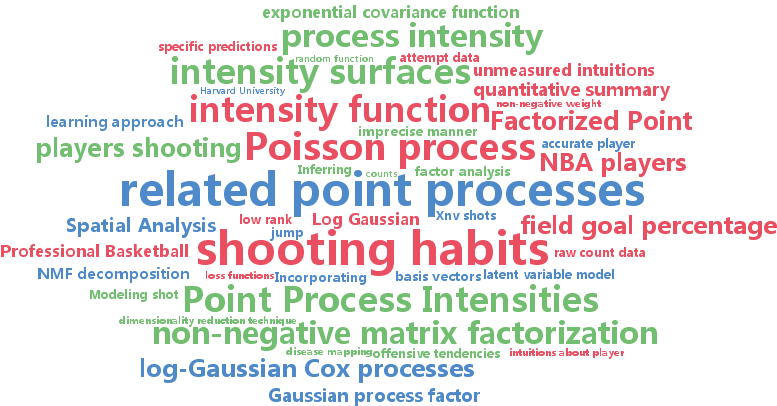non-negative matrix factorization
-
Andrew Miller and Luke Bornn and Ryan Adams and Kirk Goldsberry
Factorized Point Process Intensities: A Spatial Analysis of Professional Basketball (pdf)
We develop a machine learning approach to represent and analyze the underlying spatial structure that governs shot selection among professional basketball players in the NBA. Typically, NBA players are discussed and compared in an heuristic, imprecise manner that relies on unmeasured intuitions about player behavior. This makes it difficult to draw comparisons between players and make accurate player specific predictions. Modeling shot attempt data as a point process, we create a low dimensional representation of offensive player types in the NBA. Using non-negative matrix factorization (NMF), an unsupervised dimensionality reduction technique, we show that a low-rank spatial decomposition summarizes the shooting habits of NBA players. The spatial representations discovered by the algorithm correspond to intuitive descriptions of NBA player types, and can be used to model other spatial effects, such as shooting accuracy.
-
George Trigeorgis and Konstantinos Bousmalis and Stefanos Zafeiriou and Bjoern Schuller
A Deep Semi-NMF Model for Learning Hidden Representations (pdf)
Semi-NMF is a matrix factorization technique that learns a low-dimensional representation of a dataset that lends itself to a clustering interpretation. It is possible that the mapping between this new representation and our original features contains rather complex hierarchical information with implicit lower-level hidden attributes, that classical one level clustering methodologies can not interpret. In this work we propose a novel model, Deep Semi-NMF, that is able to learn such hidden representations that allow themselves to an interpretation of clustering according to different, unknown attributes of a given dataset. We show that by doing so, our model is able to learn low-dimensional representations that are better suited for clustering, outperforming Semi-NMF, but also other NMF variants.

